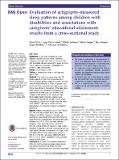| dc.contributor.author | Chen, Xiaoli | en_US |
| dc.contributor.author | Velez, Juan Carlos | en_US |
| dc.contributor.author | Barbosa, Clarita | en_US |
| dc.contributor.author | Pepper, Micah | en_US |
| dc.contributor.author | Gelaye, Bizu | en_US |
| dc.contributor.author | Redline, Susan | en_US |
| dc.contributor.author | Williams, Michelle A | en_US |
| dc.date.accessioned | 2016-01-04T19:25:35Z | |
| dc.date.issued | 2015 | en_US |
| dc.identifier.citation | Chen, Xiaoli, Juan Carlos Velez, Clarita Barbosa, Micah Pepper, Bizu Gelaye, Susan Redline, and Michelle A Williams. 2015. “Evaluation of actigraphy-measured sleep patterns among children with disabilities and associations with caregivers’ educational attainment: results from a cross-sectional study.” BMJ Open 5 (12): e008589. doi:10.1136/bmjopen-2015-008589. http://dx.doi.org/10.1136/bmjopen-2015-008589. | en |
| dc.identifier.issn | 2044-6055 | en |
| dc.identifier.uri | http://nrs.harvard.edu/urn-3:HUL.InstRepos:23993690 | |
| dc.description.abstract | Objectives: To use wrist-actrigrphy to collect objective measures of sleep and to characterise actigraphy-measured sleep patterns among children with disabilities. We also assessed the extent to which, if at all, caregivers’ education is associated with children's sleep disturbances. Design: Cross-sectional study. Setting: A rehabilitation centre in the Patagonia region, Chile. Methods: This study was conducted among 125 children aged 6–12 years with disabilities (boys: 55.2%) and their primary caregivers in Chile. Children wore ActiSleep monitors for 7 days. A general linear model was fitted to generate least-square means and SEs of sleep efficiency (proportion of the sleep period spent asleep) across caregivers’ education levels adjusting for children's age, sex, disability type, caregiver–child relationship and caregivers’ age. Multivariable logistic regression analyses were conducted to estimate ORs and 95% CIs of longer sleep latency (≥30 min) and longer wake after sleep onset (WASO) (≥90 min) (a measure of sleep fragmentation) in relation to caregivers’ educational attainment. Results: Median sleep latency was 27.3 min, WASO 88.1 min and sleep duration 8.0 h. Mean sleep efficiency was 80.0%. Caregivers’ education was positively and significantly associated with children's sleep efficiency (p trend<0.001). Adjusted mean sleep efficiency was 75.7% (SE=1.4) among children of caregivers <high school education, and 81.9% (SE=1.0) among children of caregivers >high school education. Compared to children whose caregivers had >high school, children of caregivers with <high school had higher odds of longer sleep latency (OR=3.27; 95% CI 1.12 to 9.61) and longer WASO (OR=5.95; 95% CI 1.91 to 18.53). Associations were consistent across disability types. Conclusions: Children with disabilities experience difficulties initiating sleep (prolonged sleep latency) and maintaining sleep (long WASO, low sleep efficiency). Among children with disabilities, lower level of caregivers’ education is associated with more sleep disturbances. | en |
| dc.language.iso | en_US | en |
| dc.publisher | BMJ Publishing Group | en |
| dc.relation.isversionof | doi:10.1136/bmjopen-2015-008589 | en |
| dc.relation.hasversion | http://www.ncbi.nlm.nih.gov/pmc/articles/PMC4679893/pdf/ | en |
| dash.license | LAA | en_US |
| dc.subject | SLEEP MEDICINE | en |
| dc.subject | PUBLIC HEALTH | en |
| dc.subject | EPIDEMIOLOGY | en |
| dc.title | Evaluation of actigraphy-measured sleep patterns among children with disabilities and associations with caregivers’ educational attainment: results from a cross-sectional study | en |
| dc.type | Journal Article | en_US |
| dc.description.version | Version of Record | en |
| dc.relation.journal | BMJ Open | en |
| dash.depositing.author | Gelaye, Bizu | en_US |
| dc.date.available | 2016-01-04T19:25:35Z | |
| dc.identifier.doi | 10.1136/bmjopen-2015-008589 | * |
| dash.contributor.affiliated | Gelaye, Bizu | |
| dash.contributor.affiliated | Williams, Michelle | |
| dash.contributor.affiliated | Redline, Susan | |
| dc.identifier.orcid | 0000-0001-5807-5281 | |


